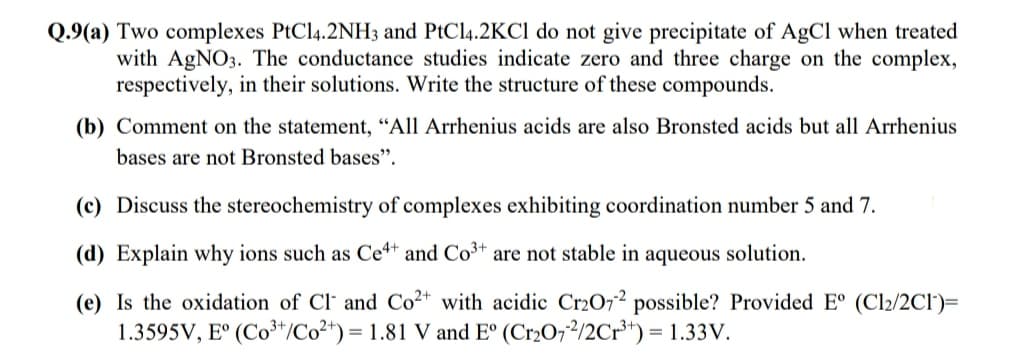Q.9(a) Two complexes PtCl4.2NH3 and PtCl4.2KCI do not give precipitate of AgCl when treated with AgNO3. The conductance studies indicate zero and three charge on the complex, respectively, in their solutions. Write the structure of these compounds.
Q.9(a) Two complexes PtCl4.2NH3 and PtCl4.2KCI do not give precipitate of AgCl when treated with AgNO3. The conductance studies indicate zero and three charge on the complex, respectively, in their solutions. Write the structure of these compounds.
Chemistry
10th Edition
ISBN:9781305957404
Author:Steven S. Zumdahl, Susan A. Zumdahl, Donald J. DeCoste
Publisher:Steven S. Zumdahl, Susan A. Zumdahl, Donald J. DeCoste
Chapter1: Chemical Foundations
Section: Chapter Questions
Problem 1RQ: Define and explain the differences between the following terms. a. law and theory b. theory and...
Related questions
Question

Transcribed Image Text:Q.9(a) Two complexes PtCl4.2NH3 and PtCl4.2KC1 do not give precipitate of AgCl when treated
with AgNO3. The conductance studies indicate zero and three charge on the complex,
respectively, in their solutions. Write the structure of these compounds.
(b) Comment on the statement, “All Arrhenius acids are also Bronsted acids but all Arrhenius
bases are not Bronsted bases".
(c) Discuss the stereochemistry of complexes exhibiting coordination number 5 and 7.
(d) Explain why ions such as Ce4t and Co³+ are not stable in aqueous solution.
(e) Is the oxidation of Cl and Co²* with acidic Cr2O7² possible? Provided E° (Cl2/2Cl)=
1.3595V, E° (Co³*/Co²*) = 1.81 V and E° (Cr»O7²/2C1³*) = 1.33V.
Expert Solution
This question has been solved!
Explore an expertly crafted, step-by-step solution for a thorough understanding of key concepts.
Step by step
Solved in 2 steps

Knowledge Booster
Learn more about
Need a deep-dive on the concept behind this application? Look no further. Learn more about this topic, chemistry and related others by exploring similar questions and additional content below.Recommended textbooks for you

Chemistry
Chemistry
ISBN:
9781305957404
Author:
Steven S. Zumdahl, Susan A. Zumdahl, Donald J. DeCoste
Publisher:
Cengage Learning

Chemistry
Chemistry
ISBN:
9781259911156
Author:
Raymond Chang Dr., Jason Overby Professor
Publisher:
McGraw-Hill Education

Principles of Instrumental Analysis
Chemistry
ISBN:
9781305577213
Author:
Douglas A. Skoog, F. James Holler, Stanley R. Crouch
Publisher:
Cengage Learning

Chemistry
Chemistry
ISBN:
9781305957404
Author:
Steven S. Zumdahl, Susan A. Zumdahl, Donald J. DeCoste
Publisher:
Cengage Learning

Chemistry
Chemistry
ISBN:
9781259911156
Author:
Raymond Chang Dr., Jason Overby Professor
Publisher:
McGraw-Hill Education

Principles of Instrumental Analysis
Chemistry
ISBN:
9781305577213
Author:
Douglas A. Skoog, F. James Holler, Stanley R. Crouch
Publisher:
Cengage Learning

Organic Chemistry
Chemistry
ISBN:
9780078021558
Author:
Janice Gorzynski Smith Dr.
Publisher:
McGraw-Hill Education

Chemistry: Principles and Reactions
Chemistry
ISBN:
9781305079373
Author:
William L. Masterton, Cecile N. Hurley
Publisher:
Cengage Learning

Elementary Principles of Chemical Processes, Bind…
Chemistry
ISBN:
9781118431221
Author:
Richard M. Felder, Ronald W. Rousseau, Lisa G. Bullard
Publisher:
WILEY